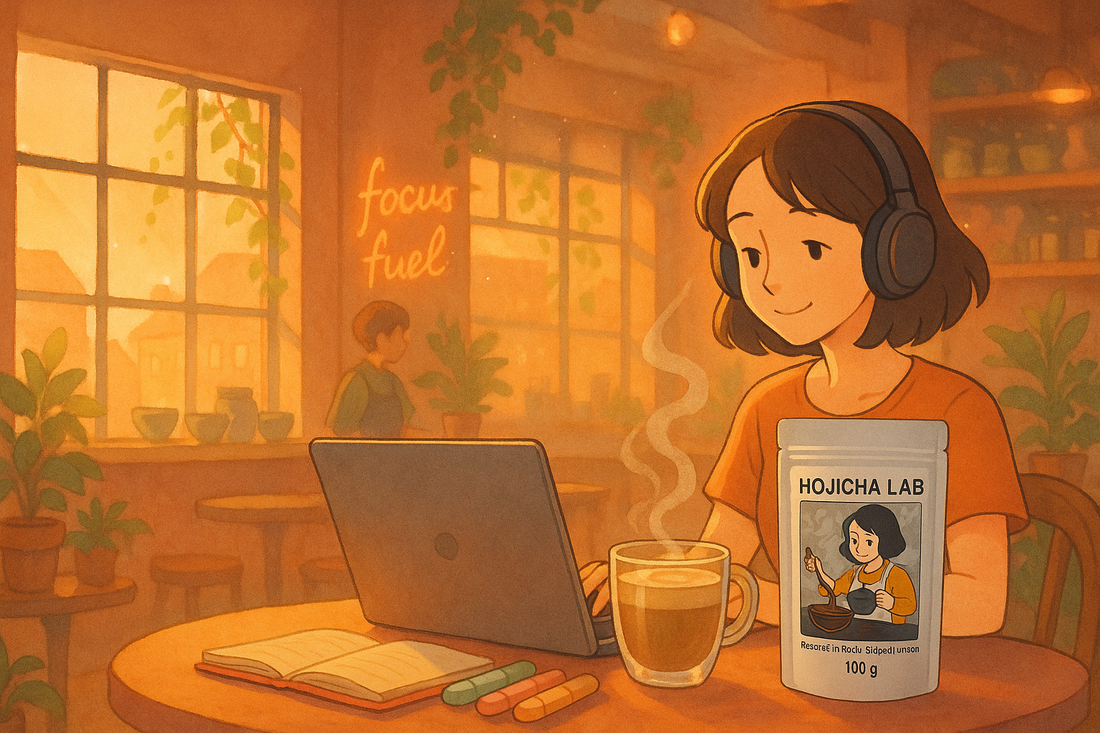
Sourcing Hojicha Sustainably: How Region & Roast Shape Flavour
Updated 22 July 2025 • 10-minute read
- Why Sustainability Matters
- Uji vs Kagoshima Map
- Roast Science & Energy Footprint
- Carbon-Neutral Shipping
- Tasting Guide
- How to Buy Sustainable Hojicha
1. Why Sustainable Hojicha Matters in 2025
Hojicha’s smoky-caramel character has made it the fastest-growing Japanese tea outside Japan (CAGR ≈ 12 %, Euromonitor 2024). Yet increased demand risks:
- Soil fatigue from synthetic fertilisers;
- High energy use during high-heat roasting (200–220 °C);
- Freight emissions on the 9 600 km voyage from Kobe to Felixstowe.
Pioneering farms and roasters in Kyoto and Kyushu now treat sustainability as a flavour enhancer, not a cost centre. By regenerating soil microbiomes, switching to biomass-powered roasters and booking carbon-neutral sea freight, they lock in terroir complexity while shrinking their carbon footprint by up to 62 % kg CO₂ e / kg tea (Tea Life-Cycle Study, Ritsumeikan Univ 2025).
2. Two Terroirs, One Vision: Uji vs Kagoshima
| Factor | Uji (Kyoto) | Kagoshima (Kyushu) |
|---|---|---|
| Latitude / Elevation | 34.9 °N • 80–250 m | 31.6 °N • 200–500 m |
| Soil | Alluvial loam, high calcium | Volcanic shirasu ash, silica-rich |
| Climate | Misty, 1 500 mm rain, cool nights | Subtropical, 2 200 mm rain, hotter days |
| Dominant Cultivar | Yabukita | Saemidori, Yutaka Midori |
| Sustainable Edge | Micro-lot organic plots, hand-picking, solar panels on ro (roasting houses) | Scale to invest in biomass roasters & drip-irrigation sensors powered by on-site solar |
Takeaway: Uji delivers silkier, layered notes ideal for straight sipping; Kagoshima produces deeper roasts perfect for lattes and baking—all while pushing the envelope on eco-tech.
3. Roast Science & Energy Footprint
3.1 Traditional Charcoal Drums
Classic Kyoto artisans roast steamed leaf (bancha or kukicha) in clay drums over binchōtan charcoal—beautiful Maillard browning but up to 6.8 kWh kg⁻¹ energy intensity.
3.2 The Sustainable Pivot
- Electric-infrared drums powered by rooftop solar cut energy use 30 % and run on renewable electricity certificates.
- Biomass gasifiers convert rice-husk waste into syngas, fuelling rotary roasters in Kagoshima; lifecycle CO₂ falls to 0.18 kg kg⁻¹ (vs 1.1 kg with propane).
- Heat-recovery exchangers pipe exhaust heat to pre-dry leaves, saving another 12 % energy.
— Yoshiko Tanaka, third-generation roaster, Uji
4. Carbon-Neutral Shipping & Packaging
4.1 Ocean > Air (Always)
A 40-ft refrigerated container (12 t tea) via Kobe → Felixstowe emits ≈ 5.2 t CO₂ e—per kilo that’s 0.43 kg, 93 % lower than air-freighting the same pallet (ICAO 2024). Elite hojicha brands lock their production calendar four months ahead so slow sea freight is viable.
4.2 Certified Offsets & Insets
- DHL GoGreen Plus: charges £0.04 kg⁻¹ to inset biofuels on the same shipping lane.
- Cool Effect #664: Uji co-ops fund verified improved cook-stoves in rural Laos—offset equals roasting emissions.
4.3 Packaging that Fits a Letterbox
Lightweight, flat kraft/PLA 100 g pouches (18 g each) fit Royal Mail’s “Large Letter” slot, halving last-mile emissions and postage. Add a QR code that links to a carbon ledger (Block-Tea chain) displaying kg CO₂ offsets per batch.
4.4 Emission Snapshot (per 100 g retail pack)
| Stage | Conventional (kg CO₂ e) | Sustainable Path |
|---|---|---|
| Farming | 0.18 | 0.11 (organic compost & shade trees) |
| Roasting | 0.10 | 0.04 (biomass + heat recovery) |
| Freight JP→UK | 0.43 (air) | 0.03 (sea + inset) |
| Packaging + Last Mile | 0.06 | 0.03 (compostable pouch + large-letter) |
| Total | 0.77 | 0.21 (-72 %) |
5. Flavour Chart: How Region & Roast Interact
| Leaf Origin | Roast Temperature / Time | Aroma | Flavour Notes | Best Applications |
|---|---|---|---|---|
| Uji Shade-grown Bancha | 200 °C • 4 min | Light smoke, toasted rice | Creamy caramel, faint chrysanthemum | Straight brew, nitro cold-brew |
| Kagoshima Machine-harvested Kukicha | 215 °C • 3 min | Walnut shell, cocoa nib | Dark chocolate, hazelnut, umami | Iced hojicha latte, baking (brownies) |
| Blended Leaves (Uji 60 % / Kagoshima 40 %) | 206 °C • 3 min 45 s | Biscuit, cedar smoke | Balanced sweetness + depth | Espresso-style concentrate, cocktails |
6. Buyer’s Checklist for Truly Sustainable Hojicha
- Transparency first: Does the product page list farm, roast date, and shipping method?
- Certifications: JAS organic, EU organic or Rainforest Alliance.
- Packaging: Look for “home-compostable” or “kerb-side recyclable” icons.
- Offset disclosure: Brands should show kg CO₂ offset per order or inset programme.
- Taste test: Sustainable shouldn’t mean bland. Seek layers—smoke, caramel, nut—without bitterness.
💡 Try it Yourself: Our Hojicha Lab Loose-Leaf ships in letterbox-friendly compostable pouches and is certified carbon-neutral.
7. The Road Ahead: Regenerative Tea & Smart Foams
Researchers at Shizuoka University are piloting mycorrhizal inoculation to raise nitrogen uptake 22 %—cutting fertiliser needs—and deploying AI-guided infrared cameras that pinpoint optimal roast end-points to within ±0.5 °C, slashing re-roast waste.
Expect to see zero-waste hojicha cafés grinding spent leaves into biodegradable foam cups and block-chain provenance labels that trace every batch from field to kettle.
8. Conclusion: Savour the Flavour, Safeguard the Planet
Sourcing sustainable hojicha is no longer a nice-to-have; it is the only route to flavour that future drinkers will accept. By championing regenerative farms in Uji, biomass-roasted leaves in Kagoshima, and carbon-neutral shipping to your door, every cup becomes a climate-positive ritual.
Ready to taste the future? Explore our Buy Hojicha Powder and experience how region and roast dance on your palate—while your conscience stays as clean as your cup.